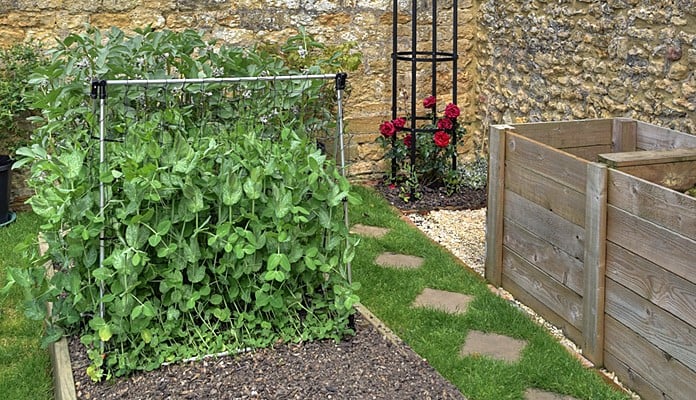Climbing plants can add great vertical interest and beauty to any garden. However, without proper support, climbing plants can easily become a tangled mess. That’s where garden frames come in handy! Garden frames provide sturdy structures for climbing plants to latch onto and grow upwards in an organized and attractive way.
Why Use Garden Frames for Climbing Plants?
There are several key benefits to using garden frames for climbing plants
-
Support – Frames provide the crucial structural support climbing plants need to grow vertically. Without a frame, vines and climbers will creep along the ground.
-
Direct Growth – Frames encourage climbing plants to grow upwards in the direction you want. This prevents tangled, wayward growth.
-
Maximize Space – Climbing upwards maximizes the planting space in your garden. Growing vertically utilizes airspace instead of spreading horizontally across the ground.
-
Ornamental Appeal – Frames create beautiful vertical gardens and attractive focal points when paired with gorgeous flowering climbers.
-
Higher Yields – Climbing plants grown on frames tend to be more productive and have higher yields than ground-creeping varieties.
-
Easier Maintenance – Keeping climbing plants neatly managed on a frame is much easier than tackling a sprawling mess!
Most Popular Frames for Climbing Plants
There are many types of garden frames suited to climbing plants. Here are some of the most popular options:
Trellises
Trellises are classic vertical frames that can be flat or diagonal. They provide excellent support for vines and climbing flowers. Trellises come in varied materials like wood, metal, and plastic. They can be freestanding or mounted on walls.
Obelisks
Obelisks are tall, slender towers that create a striking shape in the garden. Climbers wrapped around obelisks form beautiful spirals of foliage and flowers. Obelisks are usually made of metal or wood.
Arbors and Arches
Arbors and arches make dazzling walk-through displays in gardens when covered in climbers. They can be used to mark pathways, entries, or transitions between spaces. Customizable with climbers, you can create arbors that are airy, enclosed, or overhead flowering tunnels.
Pergolas
Pergolas are larger overhead structures that allow you to grow vines up columns and across open-slatted roofs. They provide shady passageways and secluded spaces perfect for relaxation.
Plant Cages and Frames
For vegetable gardens and edible climbers, plant cages and frames keep crops tidy and make picking easier. They come in various shapes like tubes, cones, and cubes.
Fences and Railings
Transformed into vertical gardens, basic fences and railings offer limitless space for climbers to scramble upwards. Attach trellising to utilize every bit.
Key Considerations When Choosing Garden Frames
With so many frame options for climbing plants, keep these key factors in mind when deciding:
-
Location – Note sunlight exposure, proximity to paths and seating areas when placing frames. Measure carefully to ensure proper fit.
-
Scale & Size – Select frames sized appropriately for the space and the mature size of climbing plants. Avoid undersized frames.
-
Durability – Look for weather resistant materials like powder-coated metals, rot-proof woods and reinforced plastics. Durability is essential.
-
Plant Varieties – Research climbing plant growth habits. Do they cling directly or need trellising? How heavy are mature plants? Match plants accordingly.
-
Aesthetics – Complement your garden style with frame shapes, colors and textures that enhance the overall design.
-
Budget – Garden frames range dramatically in price. Focus spending where frames will make the biggest visual impact.
Best Plants for Climbing Frames
With sturdy frames erected, it’s time to deck them out with gorgeous climbers! Here are some of the best plant varieties for frames:
-
Flowers – Clematis, roses, jasmine, trumpet vine, passionflower, honeysuckle, morning glory
-
Fruit – Grapes, kiwi, berries (raspberry, blackberry)
-
Vegetables – Peas, beans, cucumbers, squash, melons, tomatoes
-
Ornamental – Ivy, hydrangea, wisteria, silvervein creeper, crossvine
Setting Up Climbing Plants for Success
To get the most out of garden frames, set up climbing plants for success:
-
Enrich soil with ample compost before planting
-
Mulch around plants to retain moisture and suppress weeds
-
Water thoroughly 1-2 times per week, more in extreme heat
-
Attach climbing aids like trellising and plant ties to frames
-
Prune back wayward growth to train plants onto frames
-
Fertilize every 3-4 weeks during the growing season
-
Check for pests and diseases regularly
Enjoy Your Vertical Garden!
Adding climbing plants to garden frames creates stunning vertical gardens that maximize space while providing beauty and privacy. With a well-constructed frame and the right plant choices, you’ll enjoy a lush, flower-filled focal point in your garden. Trellis away!

20 Must-Try Garden Trellis Ideas to Elevate Your Outdoor Space!
FAQ
What garden structure supports climbing plants?
- Arches. These structures can add distinctive flair to your garden, no matter what the season. …
- Freestanding Trellises. These trellises are often used to define a space or provide a sense of privacy. …
- Obelisks and Tripods. …
- Cages and Ladders. …
- Fences. …
- Wall Trellises. …
- Planter Trellises.
What is a climbing plant frame called?
Trellises are support structures made of metal, wood or plastic, that are used as support for climbing plants.
What is the best support for climber plants?
The best support for scrambling climbers
Train yours by making a network of wires across your wall or fence, or train on a pergola, arch or through the branches of a large tree. If you use a trellis, make sure it’s a large and sturdy one which is well anchored to the wall or fence.
What is an alternative to a trellis for climbing plants?
The alternative to traditional wooden trellis is to use rope planters, metal trellis, or make your own. Be creative and use things like window frames with chicken wire attached across it, ladders, bamboo frames, pallets – anything that plants can climb up to create a screen, add privacy or vertical interest.
